Implementation of Quality Tools in Mechanical Engineering Piece Production
Abstract
:1. Introduction
- half the human labor time in production,
- reducing the number of output failures by half,
- reducing investment in machinery, tools, and equipment by 50%,
- reducing engineering by up to 60%,
- the reduction of space required by 50%,
- the reduction of inventories by 90%.
2. Materials and Methods
- To analyze the basic tools of Lean production with respect to the specifics of production conditions in a small company with piece production and to identify those that are applicable in the conditions of such a company.
- To verify the applicability of the proposed tools in the real conditions of the selected company.
- independence from the amount of input data (which the Lean tool uses to achieve the expected effect),
- ease of obtaining input data,
- ease of processing input data (sophistication necessity of using software support for processing input data),
- easy to understand principle of tool,
- the shortest time to implement a tool,
- ease of sustainability of the tool after implementation,
- economic simplicity of the tool’s sustainability after implementation.
- 2 to 1.5 points—full application,
- 1.49 to 0.9 points—limited application,
- 0 to 0.89 points—no application.
3. Results
4. Discussion
5. Conclusions
Author Contributions
Funding
Institutional Review Board Statement
Informed Consent Statement
Data Availability Statement
Conflicts of Interest
References
- Nguyen, T.M.P.; Ngo, T.H.C. Determinants Influencing the Application of Lean Accounting: The Case of Vietnamese Garment Firms. J. Risk Financ. Manag. 2023, 16, 279. [Google Scholar] [CrossRef]
- Qureshi, K.M.; Mewada, B.G.; Buniya, M.K.; Qureshi, M.R.N.M. Analyzing Critical Success Factors of Lean 4.0 Implementation in Small and Medium Enterprises for Sustainable Manufacturing Supply Chain for Industry 4.0 Using PLS-SEM. Sustainability 2023, 15, 5528. [Google Scholar] [CrossRef]
- Kotturu, C.M.V.V.; Mahanty, B. Determinants of SME integration into global value chains: Evidence from Indian automotive component manufacturing industry. J. Adv. Manag. Res. 2017, 14, 313–331. [Google Scholar] [CrossRef]
- García-Alcaraz, J.L.; Sánchez Ramírez, C. Special Issue on Applied Engineering to Lean Manufacturing and Production Systems 2020. Appl. Sci. 2022, 12, 8897. [Google Scholar] [CrossRef]
- Santos, E.; Lima, T.M.; Gaspar, P.D. Optimization of the Production Management of an Upholstery Manufacturing Process Using Lean Tools: A Case Study. Appl. Sci. 2023, 13, 9974. [Google Scholar] [CrossRef]
- Vujica, H.N.; Tonchia, S. An Instrument for Measuring the Degree of Lean Implementation in Manufacturing. Stroj. Vestn. J. Mech. Eng. 2014, 60, 797–803. [Google Scholar] [CrossRef]
- Alsmadi, M.; Almani, A.; Jerisat, R. A comparative analysis of Lean practices and performance in UK manufacturing and service sector firms. Total Qual. Manag. Bus. Excell. 2012, 23, 381–396. [Google Scholar] [CrossRef]
- Bortolotti, T.; Boscari, S.; Danese, P. Successful lean implementation: Organizational culture and soft lean practices. Int. J. Prod. Econ. 2015, 160, 182–201. [Google Scholar] [CrossRef]
- Meng, X. Lean management in the context of construction supply chains. Int. J. Prod. Res. 2019, 57, 3784–3798. [Google Scholar] [CrossRef]
- Powell, D.; Binder, A.; Arica, E. MES Support for Lean Production. In Proceedings of the Advances in Production Management Systems. Competitive Manufacturing for Innovative Products and Services, Rhodes, Greece, 24–26 September 2012. [Google Scholar]
- Liker, J.K. Toyota Way: 14 Management Principles from the World’s Greatest Manufacturer, 1st ed.; McGraw-Hill: New York, NY, USA, 2004; pp. 23–27. [Google Scholar]
- Ringen, G.; Aschehoug, S.; Holtskog, H.; Ingvaldsen, J. Integration Quality and Lean into a Holistic Production System. In Proceedings of the 47th CIRP Conference on Manufacturing Systems—Variety Management in Manufacturing, Windsor, ON, Canada, 28–30 April 2014. [Google Scholar]
- Liker, J.K.; Meier, D. The Toyota Way Fieldbook: A Practical Guide for Implementing Toyota′s 4P′s, 1st ed.; McGraw-Hill: New York, NY, USA, 2006; pp. 32–36. [Google Scholar]
- Wilson, L. How to Implement Lean Manufacturing, 1st ed.; McGraw-Hill: New York, NY, USA, 2010; pp. 75–88. [Google Scholar]
- Carreira, B. Lean Manufacturing That Works: Powerful Tools for Dramatically Reducing Waste and Maximizing Profit; American Management Association: New York, NY, USA, 2005. [Google Scholar]
- Minovski, R.; Jovanoski, B.; Galevski, P. Lean implementation and implications: Experiences from Macedonia. Int. J. Lean Six Sigma 2021, 12, 78–97. [Google Scholar] [CrossRef]
- Womack, J.P.; Jones, D.T. Lean Thinking: Banish Waste and Create Wealth in Your Corporation, 2nd ed.; Free Press: New York, NY, USA, 2003; pp. 112–129; 151–154. [Google Scholar]
- McQuater, R.E.; Scurr, C.H.; Dale, B.G.; Hillman, P.G. Using quality tools and techniques successfully. TQM Mag. 1995, 7, 37–42. [Google Scholar] [CrossRef]
- McDermott, O.; Antony, J.; Sony, M.; Fernandes, M.M.; Koul, R.; Doulatabadi, M. The Use and Application of the 7 New Quality Control Tools in the Manufacturing Sector: A Global Study. TQM J. 2023, 35, 2621–2639. [Google Scholar] [CrossRef]
- Castello, J.; De Castro, R.; Marimon, F. Use of quality tools and techniques and their integration into ISO 9001: A wind power supply chain case. Int. J. Qual. Reliab. Manag. 2020, 37, 68–89. [Google Scholar] [CrossRef]
- Bunney, H.S.; Dale, B.G. The implementation of quality management tools and techniques: A study. TQM Mag. 1997, 9, 183–189. [Google Scholar] [CrossRef]
- Rahman, S.; Laosirihongthong, T.; Sohal, A.S. Impact of lean strategy on operational performance: A study of Thai manufacturing companies. J. Manuf. Technol. Manag. 2010, 21, 839–852. [Google Scholar] [CrossRef]
- Karlsson, C.; Ahlstrom, P. Assessing changes towards lean production. Int. J. Oper. Prod. Manag. 1996, 16, 24–41. [Google Scholar] [CrossRef]
- Sanchez, A.M.; Perez, M.P. Lean indicators and manufacturing strategies. Int. J. Oper. Prod. Manag. 2001, 21, 1433–1451. [Google Scholar] [CrossRef]
- O’Donoghue, K.; Woods, B.; Morrissey, S.; Walsh, J. Adoption of Lean by AgriTech Companies in Ireland. In Proceedings of the 2023 IEEE International Symposium on Technology and Society, Swansea, UK, 13–15 September 2023. [Google Scholar]
- Demaj, E.; Mehillaj, D. Implementing Lean Manufacturing Approach in SMEs: A Case Study From the Food Processing Industry in Albania. In Digitalization, Sustainable Development, and Industry 5.0; Emerald Publishing Limited: Leeds, UK, 2023; pp. 149–162. [Google Scholar]
- Zahraee, S.M.; Golroudbary, S.R.; Hashemi, A.; Afshar, J.; Haghighi, M. Simulation of manufacturing production line based on arena. Adv. Mater. Res. 2014, 933, 744–748. [Google Scholar] [CrossRef]
- Rother, M.; Shook, J. Learning to See: Value Stream Mapping to Create Value and Eliminate Muda, 1st ed.; Lean Enterprise Institute: Boston, MA, USA, 2009; pp. 35–38. [Google Scholar]
- Nagapan, S.; Rahman, I.A.; Asmi, A.; Memon, A.H.; Zin, R.M. Identifying causes of construction waste: Case of Central Region of Peninsula Malaysia. Int. J. Integr. Eng. 2012, 4, 20–28. [Google Scholar]
- Zahraee, S.M.; Hashemi, A.; Abdi, A.A.; Shahpanah, A.; Rohani, J.M. Lean manufacturing implementation through value stream mapping: A case study. J. Teknol. 2014, 68, 119–124. [Google Scholar]
- Hatami, M.; Zahraee, S.M.; Khademi, A.; Shahpanah, A.; Rohani, J.M. Evaluating the effect of main factors in manufacturing production line based on simulation experiment. Appl. Mech. Mater. 2014, 60, 199–203. [Google Scholar] [CrossRef]
- Nikakhtar, A.; Hosseini, A.A.; Wong, K.Y.; Zavichi, A. Application of lean construction principles to reduce construction process waste using computer simulation: A case study. Int. J. Serv. Oper. Manag. 2015, 20, 461–480. [Google Scholar] [CrossRef]
- Suleiman, I.J.; Luvara, V.G.M. Factors influencing change of design of building projects during construction stage in DarEs-Salaam Tanzania. Int. J. Constr. Eng. Manag. 2016, 5, 93–101. [Google Scholar]
- Yap, J.B.H.; Low, P.L.; Wang, C. Rework in Malaysian building construction: Impacts, causes and potential solutions. J. Eng. Des. Technol. 2017, 15, 591–618. [Google Scholar] [CrossRef]
- Mpofu, B.; Ochieng, E.; Moobela, C.; Pretorius, A. Profiling causative factors leading to construction project delays in the United Arab Emirates. Eng. Constr. Archit. Manag. 2017, 24, 346–376. [Google Scholar] [CrossRef]
- Love, P.E.D.; Teo, P.; Ackermann, F.; Smith, J.; Alexander, J.; Paleneeswaran, E.; Morrison, J. Reduce rework, improve safety: An empirical inquiry into the precursors to error in construction. Prod. Plan. Control 2018, 29, 353–366. [Google Scholar] [CrossRef]
- Matthews, J.; Love, P.E.D.; Mewburn, J.; Stobaus, C.; Ramanayaka, C. Building information modelling in construction: Insights from collaboration and change management perspectives. Prod. Plan. Control 2018, 29, 202–216. [Google Scholar] [CrossRef]
- Womack, J.P.; Jones, D.T.; Roos, D. The Machine That Changed the World—The Story of Lean Production; Simon & Schuster: New York, NY, USA; Harper Perennial: New York, NY, USA, 2011; ISBN 978-07-432-9979-4. [Google Scholar]
- Proença, A.P.; Gaspar, P.D.; Lima, T.M. Lean optimization techniques for improvement of production flows and logistics management: The case study of a fruits distribution center. Processes 2022, 10, 1384. [Google Scholar] [CrossRef]
- Aka, A.; Abubakar, D.I.; Eze, C.J.; Owolabi, T. Application of lean manufacturing tools and techniques for waste reduction in Nigerian bricks production process. Eng. Constr. Archit. Manag. 2020, 27, 658–679. [Google Scholar] [CrossRef]
- Sundararajan, N.; Terkar, R. Improving productivity in fastener manufacturing through the application of Lean-Kaizen principles. Mater. Today Proc. 2022, 62, 1169–1178. [Google Scholar] [CrossRef]
- Ramakrishnan, V.; Nallusamy, S. Implementation of total productive maintenance lean tool to reduce lead time—A case study. Int. J. Mech. Eng. Technol. 2017, 8, 295–306. [Google Scholar]
- Medyński, D.; Bonarski, P.; Motyka, P.; Wysoczański, A.; Gnitecka, R.; Kolbusz, K.; Dąbrowska, M.; Burduk, A.; Pawelec, Z.; Machado, J. Digital Standardization of Lean Manufacturing Tools According to Industry 4.0 Concept. Appl. Sci. 2023, 13, 6259. [Google Scholar] [CrossRef]
- Gallo, T.; Cagnetti, C.; Silvestri, C.; Ruggieri, A. Industry 4.0 tools in lean production: A systematic literature review. Procedia Comput. Sci. 2021, 180, 394–403. [Google Scholar] [CrossRef]
- Janjić, V.; Bogicevic, J.R.; Krstić, B. Kaizen as a global business philosophy for continuous improvement of business performance. Ekonomika 2019, 65, 13–25. [Google Scholar] [CrossRef]
- Harada, T. Management Lessons from Taiichi Ohno; McGraw-Hill: New York, NY, USA, 2015. [Google Scholar]
- Purvis, B.; Mao, Y.; Robinson, D. Three pillars of sustainability: In search of conceptual origins. Sustain. Sci. 2018, 14, 681–695. [Google Scholar] [CrossRef]
- Foley, I.; McDermott, O.; Rosa, A.; Kharub, M. Implementation of a Lean 4.0 Project to Reduce Non-Value Add Waste in a Medical Device Company. Machines 2022, 10, 1119. [Google Scholar] [CrossRef]
- García-Alcaraz, J.L.; Sánchez Ramírez, C. Special Issue on Applied Engineering to Lean Manufacturing Production Systems. Appl. Sci. 2022, 12, 8609. [Google Scholar] [CrossRef]
- Oliveira, C.; Lima, T.M. Setup Time Reduction of an Automotive Parts Assembly Line Using Lean Tools and Quality Tools. Eng 2023, 4, 2352–2362. [Google Scholar] [CrossRef]
- Androniceanu, A.; Enache, I.-C.; Valter, E.-N.; Raduica, F.-F. Increasing Energy Efficiency Based on the Kaizen Approach. Energies 2023, 16, 1930. [Google Scholar] [CrossRef]
- Langlotz, P.; Siedler, C.; Aurich, J.C. Unification of lean production and industry 4.0. Procedia CIRP 2021, 99, 15–20. [Google Scholar] [CrossRef]
- Moeuf, A.; Pellerin, R.; Lamouri, S.; Tamayo-Giraldo, S.; Barbaray, R. The industrial management of SMEs in the era of Industry 4.0. Int. J. Prod. Res. 2018, 56, 1118–1136. [Google Scholar] [CrossRef]
- Poswa, F.; Adenuga, O.T.; Mpofu, K. Productivity Improvement Using Simulated Value Stream Mapping: A Case Study of the Truck Manufacturing Industry. Processes 2022, 10, 1884. [Google Scholar] [CrossRef]
- Matenga, A.E.; Mpofu, K. Blockchain-Based Cloud Manufacturing SCM System for Collaborative Enterprise Manufacturing: A Case Study of Transport Manufacturing. Appl. Sci. 2022, 12, 8664. [Google Scholar] [CrossRef]
- Niekurzak, M.; Lewicki, W.; Coban, H.H.; Bera, M. A Model to Reduce Machine Changeover Time and Improve Production Efficiency in an Automotive Manufacturing Organisation. Sustainability 2023, 15, 10558. [Google Scholar] [CrossRef]
- Tsao, Y.C.; Lee, P.L.; Liao, L.W.; Zhang, Q.; Vu, T.L.; Tsai, J. Imperfect economic production quantity models under predictive maintenance and reworking. Int. J. Syst. Sci. Oper. Logist. 2020, 7, 347–360. [Google Scholar] [CrossRef]
- Umar, R.Z.R.; Tiong, J.Y.; Ahmad, N.; Dahalan, J. Development of framework integrating ergonomics in Lean’s Muda, Muri, and Mura concepts. Prod. Plan. Control. 2023, 24, 1–9. [Google Scholar] [CrossRef]
- Heston, T. Ergonomics: The First Step to Lean. Fabr. Metalwork. 2006, 5, 52. [Google Scholar]
- Nagamachi, M. Japanese Style of production system after lean production. In First World Congress on Ergonomics for Global Quality and Productivity; Educational Technology Center: Hong Kong, China, 1998; Volume 8, pp. 109–112. [Google Scholar]
- Karthika Devi, M.S.; Bhuvaneshwari, R.; Kavin Pragadeesh, K.; Ramachandran, B. IPD—An Investment Portfolio Detector Using SEBI API. In Information and Communication Technology for Competitive Strategies (ICTCS 2021) Intelligent Strategies for ICT; Springer Nature: Singapore, 2022; pp. 555–567. [Google Scholar] [CrossRef]
- Jia, F. Enterprise management and monitoring in the background of big data and Internet of Things. J. Comput. Methods Sci. Eng. 2023, 23, 1679–1690. [Google Scholar] [CrossRef]
- Vuković, M.; Jorg, O.; Hosseinifard, M.; Fantoni, G. Low-Cost Digitalization Solution through Scalable IIoT Prototypes. Appl. Sci. 2022, 12, 8571. [Google Scholar] [CrossRef]
- Jiang, D.; Ni, Z.; Chen, Y.; Chen, X.; Na, C. Influence of Financial Shared Services on the Corporate Debt Cost under Digitalization. Sustainability 2023, 15, 428. [Google Scholar] [CrossRef]
- Sabih, M.; Farid, M.S.; Ejaz, M.; Husam, M.; Khan, M.H.; Farooq, U. Raw Material Flow Rate Measurement on Belt Conveyor System Using Visual Data. Appl. Syst. Innov. 2023, 6, 88. [Google Scholar] [CrossRef]
- Furman, J.; Małysa, T. The role of visual management in the organization of safe work in production companies. Prod. Eng. Arch. 2023, 29, 195–200. [Google Scholar] [CrossRef]
- Mazur, M.; Momeni, H. Lean production issues in the organization of the company—The first stage. Prod. Eng. Arch. 2018, 21, 36–39. [Google Scholar] [CrossRef]
- Sá, J.C.; Manuel, V.; Silva, F.J.G.; Santos, G.; Ferreira, L.P.; Pereira, T.; Carvalho, M. Lean Safety-assessment of the impact of 5S and Visual Management on safety. IOP Conference Series: Materials Science and Engineering; IOP Publishing: Bristol, UK, 2021; Volume 1193, p. 012049. [Google Scholar] [CrossRef]
- Chałada, M. Sustainable supply chain on the example of the steel sector in Poland. Metalurgija 2023, 162, 164–166. [Google Scholar]
- Furman, J.; Kuczyńska-Chałada, M. Change management in lean enterprise. Eng. Manag. Prod. Serv. 2016, 8, 23–30. [Google Scholar] [CrossRef]
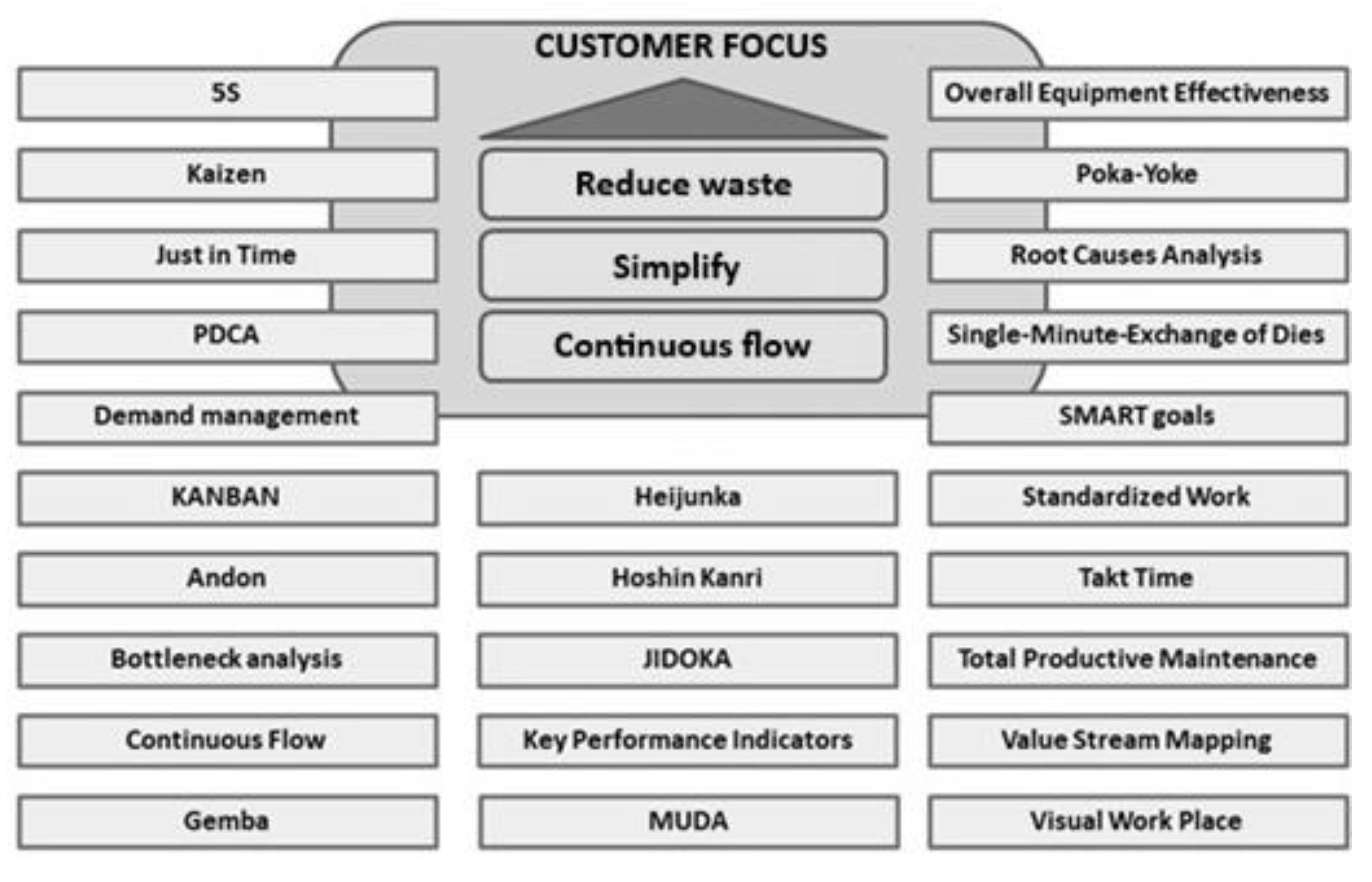
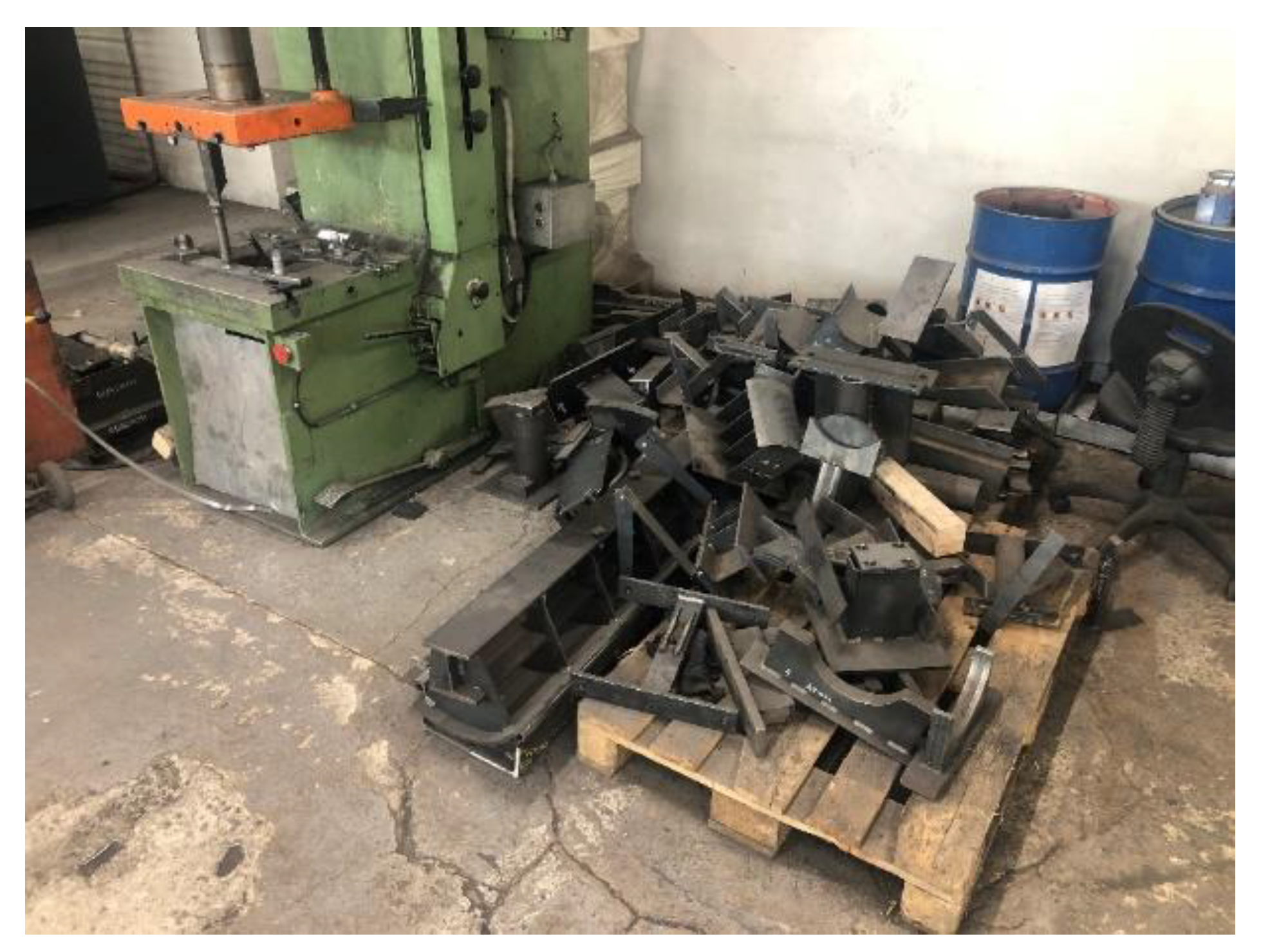
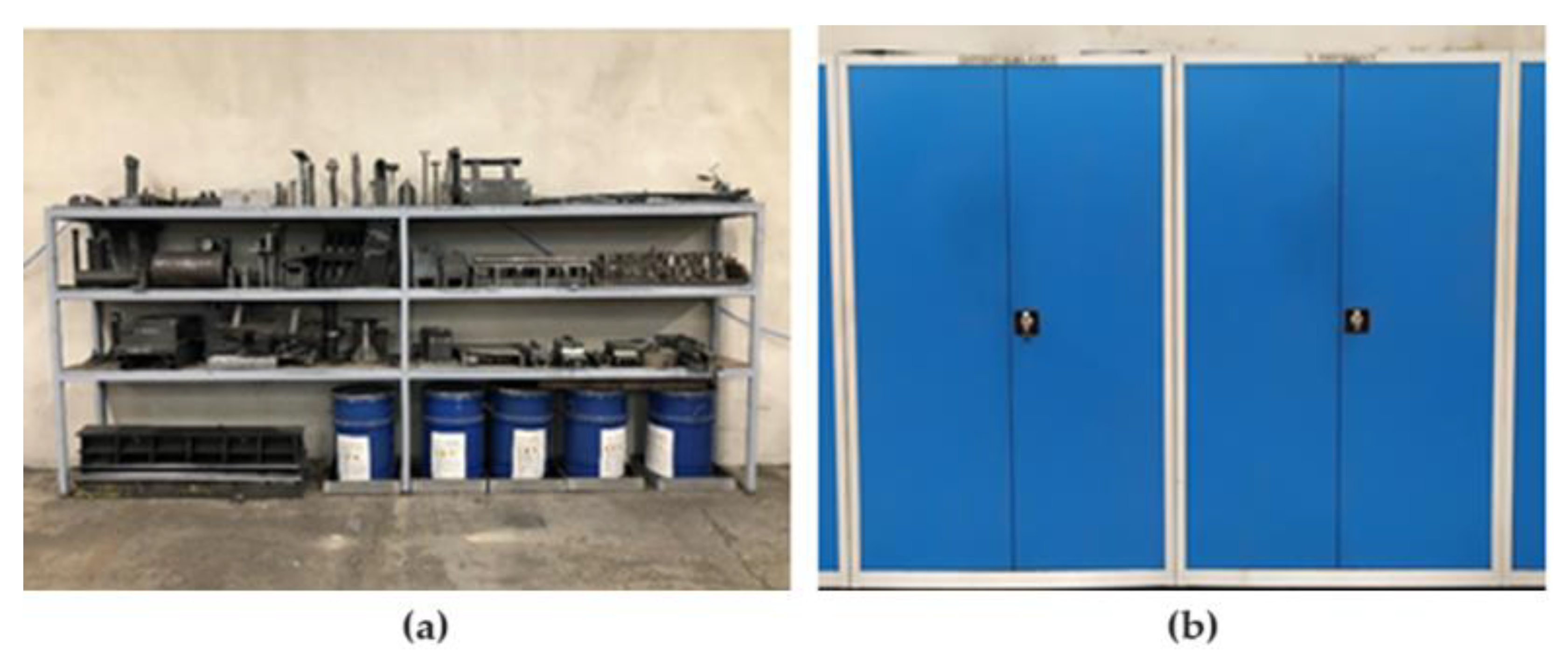

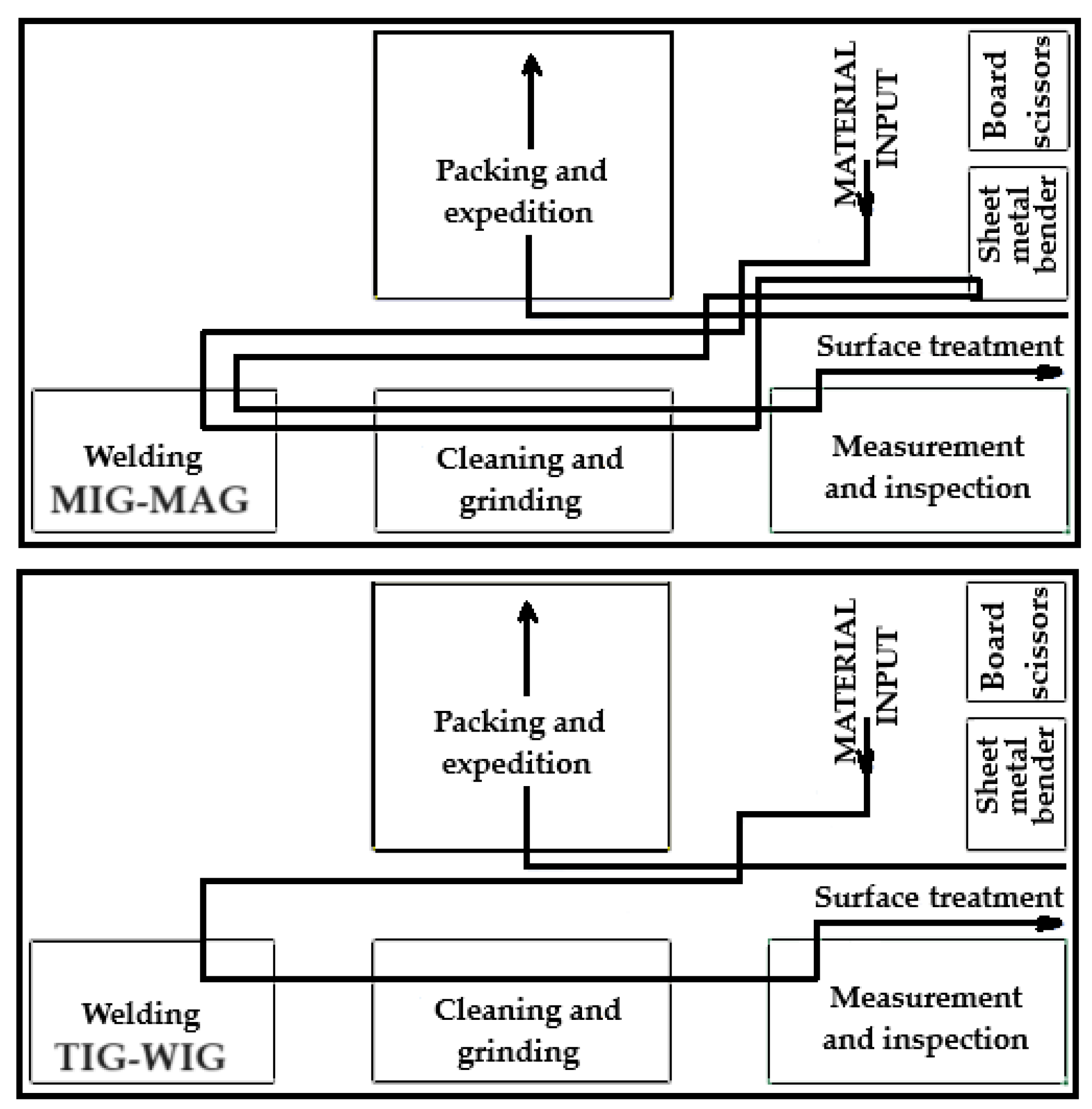

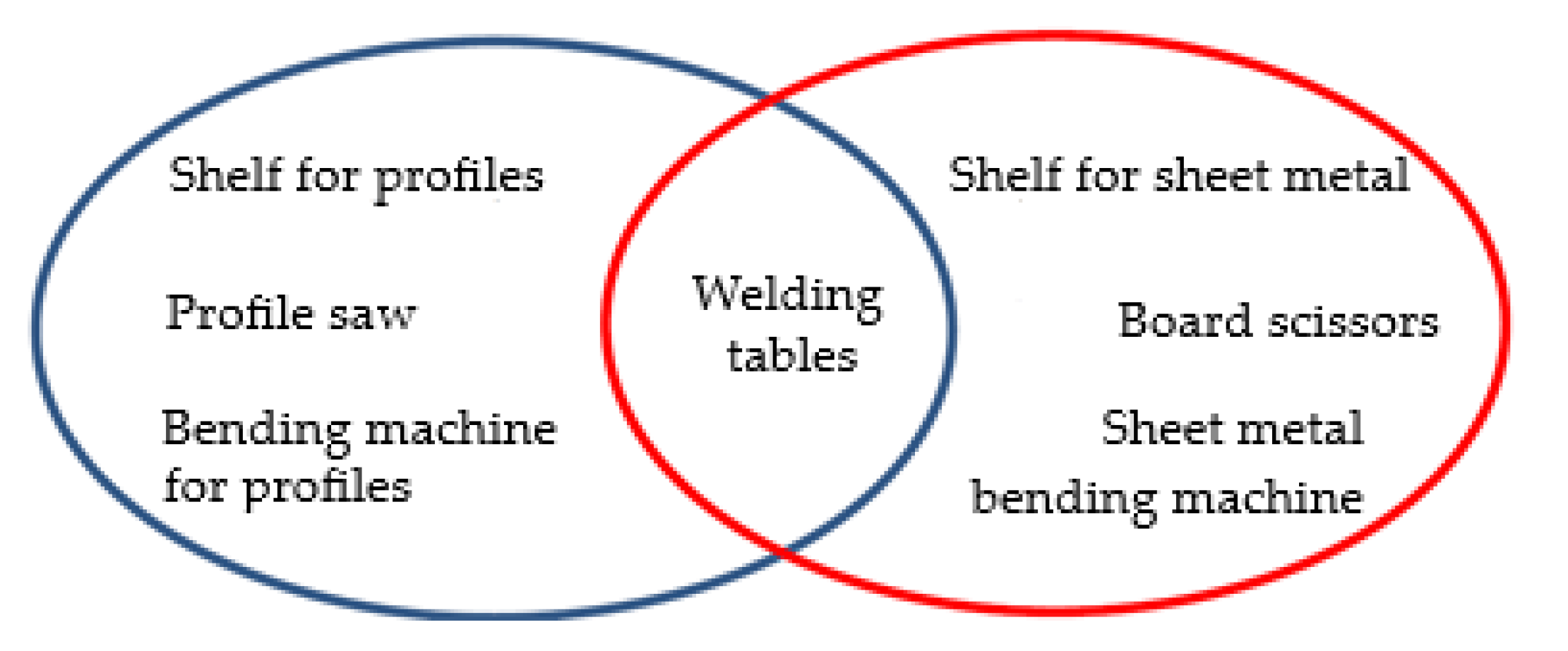

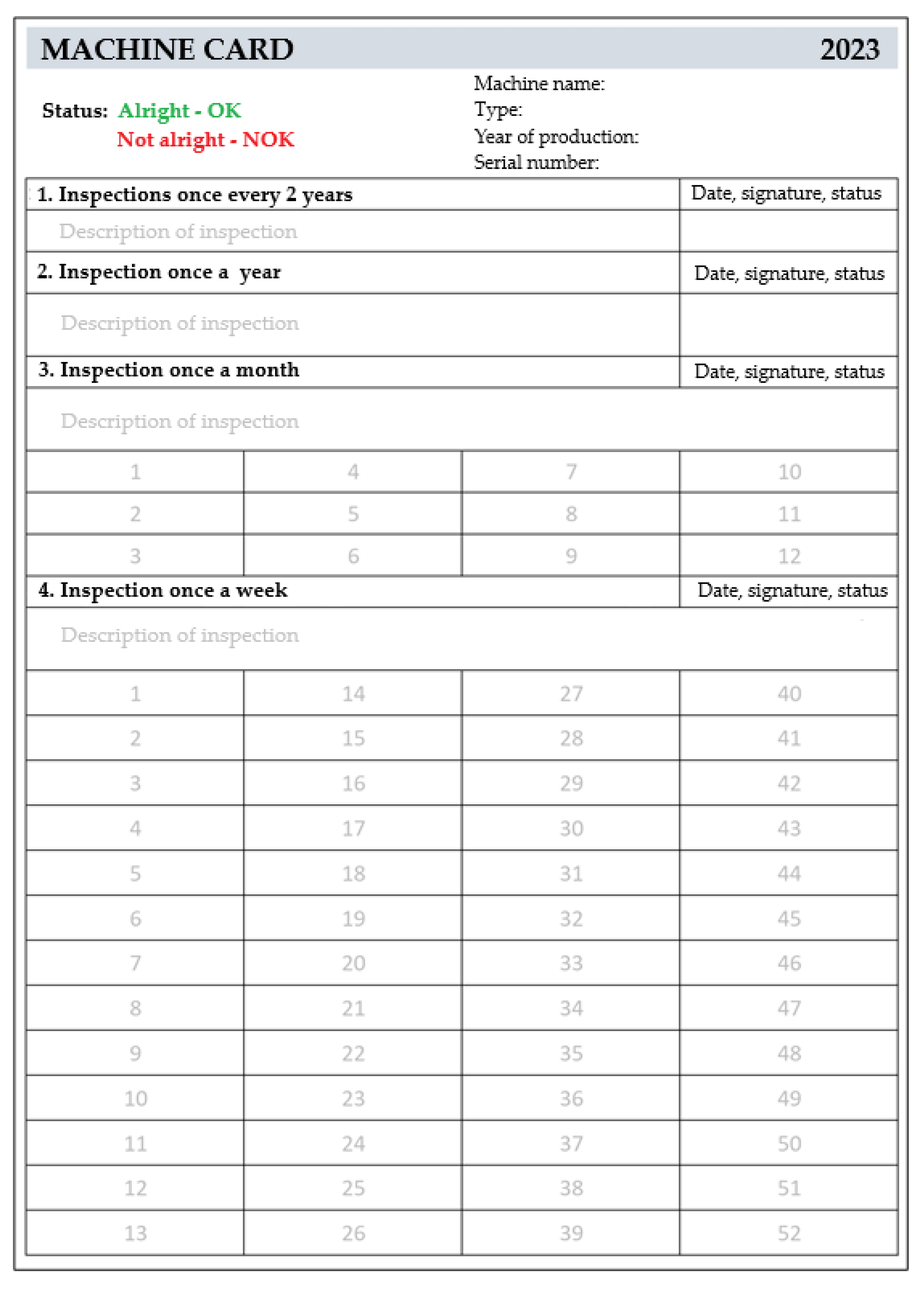


| Piece Production | Serial (Mass) Production | |
|---|---|---|
| Production quantity | Production of unique products or products in small series. Each product is individual and adapted to the needs of the customer. | Production of many of the same products. The production process is standardized and repetitive. |
| Flexibility | High flexibility. Adaptation of the production process to the individual needs of the customer. Each product may be different. | Less flexible. Focus on mass production of identical products. There are costly and fundamental changes in the production process. |
| Automatization | Less automated. It depends more on manual work or individual craft. | A large degree of automation with the use of special machines, conveyors, and robots. |
| Storage and distribution | A minor problem with storage. Products are made to order. | It requires a better organization of storage and distribution due to the larger volume of products. |
| Time and cost | More demanding on time and costs. Each product is produced individually. It is suitable for special, unique, or customized products. | More efficient in terms of time and costs. The production process is optimized to produce many of the same products. |
| Researcher A | Researcher B | Researcher C | Score | Weight of Criteria | |
|---|---|---|---|---|---|
| Volume of input data (which the Lean tool uses to achieve the expected effect) | 3 | 7 | 2 | 12 | 0.14 |
| The difficulty of obtaining input data | 5 | 3 | 5 | 13 | 0.15 |
| Method of processing input data (sophistication necessity of using software support for processing input data) | 4 | 6 | 4 | 14 | 0.17 |
| Difficulty in understanding the principle of operation of the tool of the interested parties of the company | 6 | 4 | 7 | 17 | 0.20 |
| Time required to implement the tool | 7 | 5 | 6 | 18 | 0.21 |
| Time sustainability of the tool after implementation | 1 | 2 | 3 | 6 | 0.07 |
| Economic difficulty | 2 | 1 | 1 | 4 | 0.05 |
| Independence from the Amount of Input Data | Ease of Obtaining Input Data | Ease of Processing Input Data | Easy to Understand Principle of Tool | The Shortest Time to Implement a Tool | Ease of Sustainability of the Tool after Implementation | Economic Simplicity of the Tool’s Sustainability after Implementation | Result | |
|---|---|---|---|---|---|---|---|---|
| Weight of criteria | 0.14 | 0.15 | 0.17 | 0.2 | 0.21 | 0.07 | 0.05 | 1 |
| 5S | 1 | 2 | 2 | 2 | 2 | 2 | 1 | 12 |
| 0.14 | 0.3 | 0.34 | 0.4 | 0.42 | 0.14 | 0.05 | 1.79 | |
| Kaizen | 2 | 1 | 2 | 2 | 2 | 1 | 2 | 12 |
| 0.28 | 0.15 | 0.34 | 0.4 | 0.42 | 0.07 | 0.1 | 1.76 | |
| JIT | 0 | 0 | 1 | 1 | 1 | 1 | 1 | 5 |
| 0 | 0 | 0.17 | 0.2 | 0.21 | 0.07 | 0.05 | 0.7 | |
| PDCA | 1 | 2 | 2 | 2 | 2 | 2 | 2 | 13 |
| 0.14 | 0.3 | 0.34 | 0.4 | 0.42 | 0.14 | 0.1 | 1.84 | |
| Demand Manag. | 0 | 0 | 0 | 0 | 1 | 1 | 1 | 3 |
| 0 | 0 | 0 | 0 | 0.21 | 0.14 | 0.05 | 0.4 | |
| Kanban | 0 | 1 | 1 | 0 | 1 | 1 | 2 | 6 |
| 0 | 0.15 | 0.17 | 0 | 0.21 | 0.07 | 0.1 | 0.7 | |
| Andon | 2 | 1 | 1 | 2 | 0 | 2 | 0 | 8 |
| 0.28 | 0.15 | 0.17 | 0 | 0 | 0.14 | 0 | 0.74 | |
| Bottleneck Analysis | 0 | 0 | 0 | 1 | 0 | 1 | 2 | 4 |
| 0 | 0 | 0 | 0.2 | 0 | 0.07 | 0.1 | 0.37 | |
| Continuous Flow | 0 | 1 | 1 | 1 | 1 | 1 | 1 | 6 |
| 0 | 0.15 | 0.17 | 0.2 | 0.21 | 0.07 | 0.05 | 0.85 | |
| Gemba | 2 | 2 | 2 | 1 | 2 | 2 | 1 | 12 |
| 0.28 | 0.3 | 0.34 | 0.2 | 0.42 | 0.14 | 0.05 | 1.73 | |
| Heijunka | 0 | 0 | 0 | 1 | 0 | 2 | 1 | 4 |
| 0 | 0 | 0 | 0.2 | 0 | 0.14 | 0.05 | 0.39 | |
| Hoshin Kanri | 0 | 0 | 0 | 1 | 0 | 1 | 1 | 3 |
| 0 | 0 | 0 | 0.2 | 0 | 0.07 | 0.05 | 0.32 | |
| Jidoka | 0 | 0 | 0 | 1 | 1 | 0 | 0 | 2 |
| 0 | 0 | 0 | 0.2 | 0.21 | 0 | 0 | 0.41 | |
| KPI | 0 | 0 | 1 | 2 | 1 | 1 | 2 | 7 |
| 0 | 0 | 0.17 | 0.4 | 0.21 | 0.07 | 0.01 | 0.86 | |
| Muda | 1 | 2 | 2 | 2 | 2 | 1 | 1 | 11 |
| 0.14 | 0.3 | 0.34 | 0.4 | 0.42 | 0.07 | 0.05 | 1.72 | |
| OEE | 0 | 0 | 0 | 1 | 1 | 1 | 1 | 3 |
| 0 | 0 | 0 | 0.2 | 0.21 | 0.07 | 0.05 | 0.53 | |
| Poka-Yoke | 1 | 1 | 1 | 1 | 0 | 0 | 1 | 5 |
| 0.14 | 0.15 | 0.17 | 0.2 | 0 | 0 | 0.05 | 0.71 | |
| Root Cause Analysis | 0 | 1 | 1 | 1 | 0 | 1 | 1 | 6 |
| 0 | 0.15 | 0.17 | 0.4 | 0 | 0.07 | 0.05 | 0.84 | |
| SMED | 0 | 0 | 0 | 1 | 1 | 1 | 1 | 4 |
| 0 | 0 | 0 | 0.2 | 0.21 | 0.07 | 0.05 | 0.53 | |
| Smart goals | 2 | 2 | 1 | 2 | 2 | 2 | 2 | 13 |
| 0.28 | 0.3 | 0.17 | 0.4 | 0.42 | 0.14 | 0.1 | 1.81 | |
| Standarized Work | 0 | 1 | 1 | 1 | 0 | 2 | 2 | 7 |
| 0 | 0.15 | 0.17 | 0.2 | 0 | 0.14 | 0.1 | 0.76 | |
| Takt time | 0 | 0 | 0 | 0 | 1 | 1 | 1 | 3 |
| 0 | 0 | 0 | 0 | 0.21 | 0.07 | 0.05 | 0.33 | |
| TPM | 0 | 0 | 1 | 1 | 1 | 2 | 0 | 6 |
| 0 | 0 | 0.17 | 0.2 | 0.21 | 0.14 | 0 | 0.72 | |
| VSM | 0 | 0 | 0 | 1 | 0 | 1 | 1 | 3 |
| 0 | 0 | 0 | 0.2 | 0 | 0.07 | 0.05 | 0.32 | |
| Visual Workplace | 2 | 2 | 2 | 2 | 1 | 2 | 2 | 13 |
| 0.28 | 0.3 | 0.34 | 0.4 | 0.21 | 0.14 | 0.05 | 1.72 |
| Tool of Lean Philosophy | Applicability | |||
|---|---|---|---|---|
| Yes | Limited | No | ||
| 1 | 5S | x | ||
| 2 | Kaizen | x | ||
| 3 | Just in Time | x | ||
| 4 | PDCA | x | ||
| 5 | Demand Management | x | ||
| 6 | Kanban | x | ||
| 7 | Andon | x | ||
| 8 | Bottleneck Analysis | x | ||
| 9 | Continuous Flow | x | ||
| 10 | Gemba | x | ||
| 11 | Heijunka | x | ||
| 12 | Hoshin Kanri | x | ||
| 13 | Jidoka | x | ||
| 14 | Key Performance Indicators | x | ||
| 15 | Muda | x | ||
| 16 | Overall Equipment Effectiveness | x | ||
| 17 | Poka-Yoke | x | ||
| 18 | Root Cause Analysis | x | ||
| 19 | Single-Minute Exchange of Dies | x | ||
| 20 | SMART Goals | x | ||
| 21 | Standardized Work | x | ||
| 22 | Takt Time | x | ||
| 23 | Total Productive Maintenance | x | ||
| 24 | Value Stream Mapping | x | ||
| 25 | Visual Workplace | x | ||
| Operation | Time before (s) | Time after (s) | Reduction (%) |
|---|---|---|---|
| Bending | 25.5 | 21 | 18 |
| Welding | 45 | 36 | 20 |
| Grinding | 15 | 14 | 7 |
| TOTAL: | 85.5 | 71 | 17 |
Disclaimer/Publisher’s Note: The statements, opinions and data contained in all publications are solely those of the individual author(s) and contributor(s) and not of MDPI and/or the editor(s). MDPI and/or the editor(s) disclaim responsibility for any injury to people or property resulting from any ideas, methods, instructions or products referred to in the content. |
© 2024 by the authors. Licensee MDPI, Basel, Switzerland. This article is an open access article distributed under the terms and conditions of the Creative Commons Attribution (CC BY) license (https://creativecommons.org/licenses/by/4.0/).
Share and Cite
Markulik, Š.; Šolc, M.; Fiľo, M. Implementation of Quality Tools in Mechanical Engineering Piece Production. Appl. Sci. 2024, 14, 944. https://doi.org/10.3390/app14020944
Markulik Š, Šolc M, Fiľo M. Implementation of Quality Tools in Mechanical Engineering Piece Production. Applied Sciences. 2024; 14(2):944. https://doi.org/10.3390/app14020944
Chicago/Turabian StyleMarkulik, Štefan, Marek Šolc, and Milan Fiľo. 2024. "Implementation of Quality Tools in Mechanical Engineering Piece Production" Applied Sciences 14, no. 2: 944. https://doi.org/10.3390/app14020944
APA StyleMarkulik, Š., Šolc, M., & Fiľo, M. (2024). Implementation of Quality Tools in Mechanical Engineering Piece Production. Applied Sciences, 14(2), 944. https://doi.org/10.3390/app14020944









